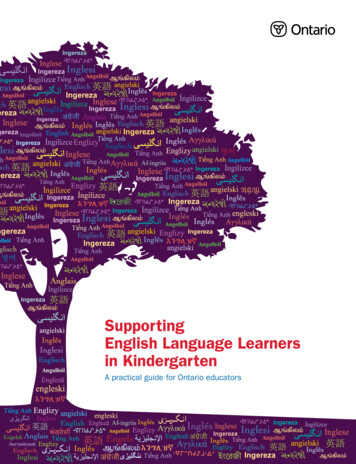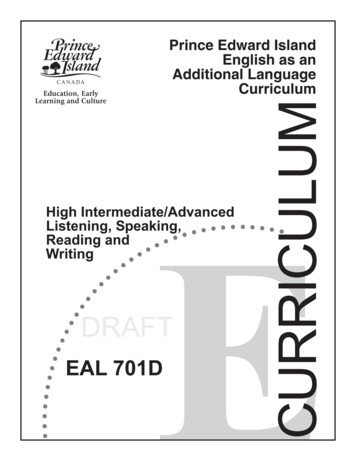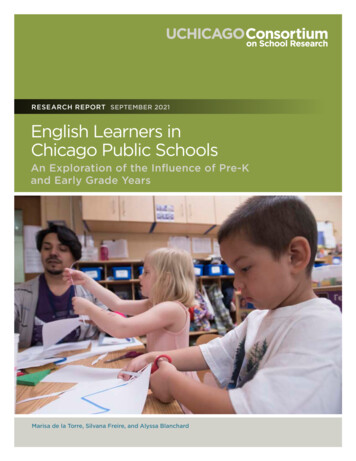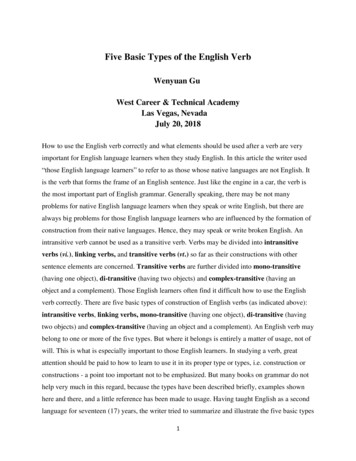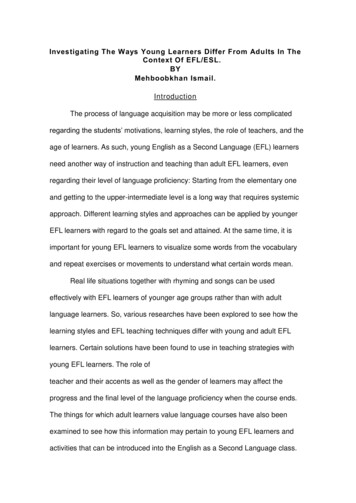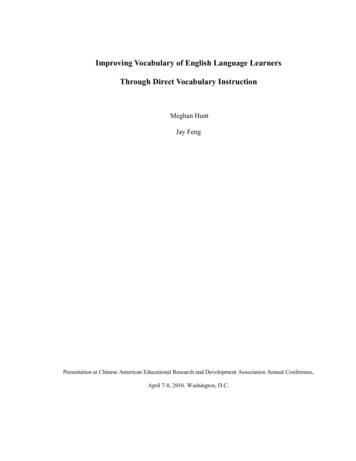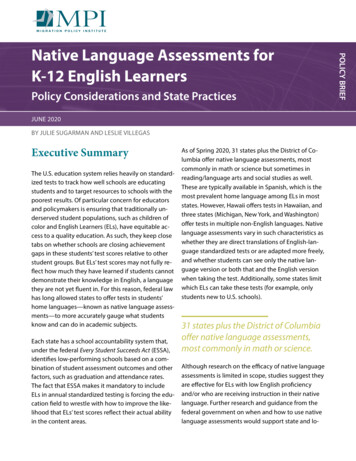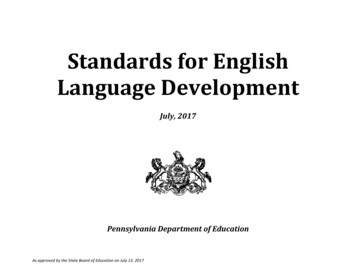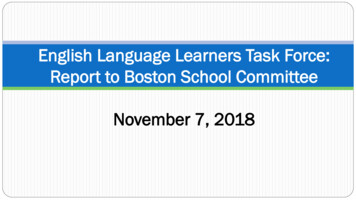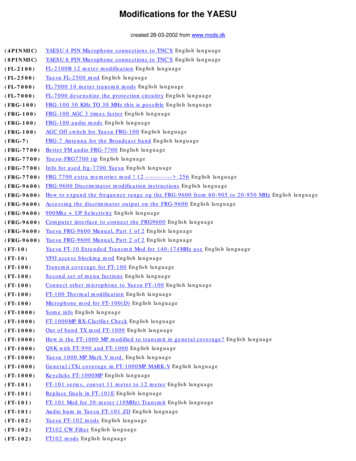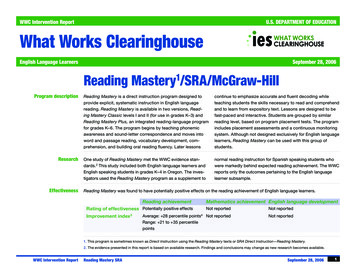
Transcription
WWC Intervention ReportU.S. DEPARTMENT OF EDUCATIONWhat Works ClearinghouseEnglish Language LearnersSeptember 28, 2006Reading Mastery1/SRA/McGraw-HillProgram descriptionResearchEffectivenessReading Mastery is a direct instruction program designed toprovide explicit, systematic instruction in English languagereading. Reading Mastery is available in two versions, Reading Mastery Classic levels I and II (for use in grades K–3) andReading Mastery Plus, an integrated reading-language programfor grades K–6. The program begins by teaching phonemicawareness and sound-letter correspondence and moves intoword and passage reading, vocabulary development, comprehension, and building oral reading fluency. Later lessonscontinue to emphasize accurate and fluent decoding whileteaching students the skills necessary to read and comprehendand to learn from expository text. Lessons are designed to befast-paced and interactive. Students are grouped by similarreading level, based on program placement tests. The programincludes placement assessments and a continuous monitoringsystem. Although not designed exclusively for English languagelearners, Reading Mastery can be used with this group ofstudents.One study of Reading Mastery met the WWC evidence standards.2 This study included both English language learners andEnglish speaking students in grades K–4 in Oregon. The investigators used the Reading Mastery program as a supplement tonormal reading instruction for Spanish speaking students whowere markedly behind expected reading achievement. The WWCreports only the outcomes pertaining to the English languagelearner subsample.Reading Mastery was found to have potentially positive effects on the reading achievement of English language learners.Reading achievementRating of effectiveness Potentially positive effectsImprovement index3Mathematics achievement English language developmentNot reportedNot reportedAverage: 28 percentile points4 Not reportedRange: 21 to 35 percentilepointsNot reported1. This program is sometimes known as Direct Instruction using the Reading Mastery texts or SRA Direct Instruction—Reading Mastery.2. The evidence presented in this report is based on available research. Findings and conclusions may change as new research becomes available.WWC Intervention ReportReading Mastery SRASeptember 28, 20061
Additional programinformationDeveloper and contactDeveloped by Dr. Siegfried Engelmann under the title Distar Reading for use in Project Follow Through as part of the DirectInstruction teaching model. Distributed by SRA/McGraw Hill.220 East Danieldale Road, DeSoto, TX 75115-2490. Web: www.sraonline.com. Email: SRA CustomerService@mcgraw-hill.com.Telephone: (201) 512-0909Scope of useEarly versions of Reading Mastery were developed during the1960s and 1970s, and have since been widely used. The Reading Mastery program has been updated throughout the yearsand now exists in two forms: Reading Mastery Classic (K–3) andReading Mastery Plus (K–6). More than 1 million students in onethird of the nation’s schools use a direct instruction program.TeachingReading Mastery uses 30- to 45-minute lessons designed tofacilitate teacher-student interactions and active student participation. A typical lesson includes seven to nine short activitiesthat encompass multiple strands of content, such as phonemicResearchOne study (Gunn, Biglan, Smolkowski, & Ary, 2000) reviewedby the WWC investigated the effects of supplemental readinginstruction using Reading Mastery on English language learners.It is part of a larger study that includes both English languagelearners and English speaking students. The English languagelearner subsample is the focus of this WWC report. The studywas a randomized controlled trial that met WWC evidencestandards.5 The intervention group received their usual readinginstruction supplemented by Reading Mastery if they werebeginning readers in grades 1 or 2. Students below grade level ingrades 3 or 4 were put into an appropriate level of SRA Corrective Reading.6 Both programs include components that facilitateawareness, letter-sound correspondence, sounding out words,word recognition, vocabulary, oral reading fluency, and comprehension. The overarching teaching routine repeated throughoutthe curriculum is composed of the following steps: modeling newcontent, providing guided practice, and implementing individualpractice and application. Lesson scripts act as a guide for teachers. Signals and group responses are used to keep studentsinvolved and on task—and to control lesson pacing.CostStudent materials include nonconsumable storybooks or textbooks and workbooks. The cost per student ranges from 100 to 150 for the first year of implementation. Replacement workbookscost between 15 and 25 a student in subsequent years. A fullset of teaching materials—a one time purchase—costs between 600 and 900 for each grade level. Additional componentsinclude literature collections ( 80– 140), Independent Readers(approximately 400 a grade level), and seatwork blacklinemasters ( 57). A videotape series of 12 tapes ( 145) supplementsconsultant-led professional development ( 1,500 a day).the development of beginning reading skills, but the programsdiffer in instructional methodology. Reading Mastery and Corrective Reading both entail explicit instruction in phonemic awareness, sound-letter correspondence, and blending. New soundswere introduced to students assigned to the Corrective Readinggroup at a faster pace than to students in the Reading Masterygroup, and stories used for the Corrective Reading group wereselected based on their appeal to older students.Gunn and colleagues (2000) was a two-year study thatincluded a one-year follow-up. This WWC report focuses on asubsample of the larger study, addressing students classified asEnglish language learners (17 of 122 K–3 students).3. These numbers show the average and range of improvement indices for all findings across the study.4. Due to a very small sample size, these results should be interpreted with caution. See the WWC Reading Mastery Technical Appendices for further details.5. The study also investigated the impact of Corrective Reading, which is also a direct instruction program intended for struggling readers in grade 3 to adulthood. The findings from this program did notapply to the current report because the English language learner subsample received instruction with Reading Mastery only. This was determined after corresponding with the first author of the study.6. Students were in kindergarten, first, and second grades during Time 1 screening, prior to intervention implementation, so they were in first, second, and third grades at the start of the intervention year.WWC Intervention ReportReading Mastery SRASeptember 28, 20062
EffectivenessThe WWC found ReadingMastery to have potentiallypositive effects on Englishlanguage learners’reading achievementReferencesFindingsThe WWC review of English language learner interventionsaddresses student outcomes in three domains: readingachievement, mathematics achievement, and English languagedevelopment.7Reading achievement. Gunn et al. (2000) found that the intervention had statistically significant effects on reading achievement.According to WWC criteria, Read Mastery had substantivelyimportant effects for four of the five measures immediately afterimplementation of the program (oral reading fluency, letter/wordidentification, word attack, and reading vocabulary but not passagecomprehension). After one year, three of the five outcome measuresshowed substantively important effects (word attack, readingvocabulary, and passage comprehension but not oral readingfluency or letter/word identification). This one study, which used astrong design, met WWC criteria for potentially positive effects.Improvement indexFor each outcome domain, the WWC computed an improvementindex based on the effect size (see the Technical Details ofWWC-Conducted Computations). The improvement index represents the difference between the percentile rank of the averagestudent in the intervention condition versus the percentile rankof the average student in the comparison condition. Unlike therating of effectiveness, the improvement index is based entirelyon the size of the effect, regardless of the statistical significanceof the effect, the study design, or the analysis. The improvementindex can take on values between –50 and 50, with positivenumbers denoting favorable results. The average improvementindex for reading achievement is 27 percentile points, with arange of 21 to 35 percentile points across findings.Met WWC evidence standardsGunn, B., Biglan, A., Smolkowski, K., & Ary, D. (2000). Theefficacy of supplemental instruction in decoding skills for Hispanic and non-Hispanic students in early elementary school.The Journal of Special Education, 34, 90–103.Additional source:Gunn, B. Smolkowski, K., Biglan, A., & Black, C. (2002).Supplemental instruction in decoding skills for Hispanicand non-Hispanic students in early elementary school: Afollow-up. The Journal of Special Education, 36, 69–79.Rating of effectivenessThe WWC rates interventions as positive, potentially positive,mixed, no discernible effects, potentially negative, or negative.The rating of effectiveness takes into account four factors: thequality of the research design, the statistical significance of thefindings (as calculated by the WWC), the size of the differencebetween participants in the intervention condition and the comparison condition, and the consistency in findings across studies(see the WWC Intervention Rating Scheme).SummaryThe one study on Reading Mastery reviewed by the WWC metWWC evidence standards. This study found potentially positiveeffects in the reading achievement domain. The evidence presentedin this report is limited and may change as new research emerges.For more information about specific studies and WWC calculations, please see the WWC Reading MasteryTechnical Appendices.7. The level of statistical significance was reported by the study authors or, where necessary, calculated by the WWC to correct for clustering within classrooms or schools and for multiple comparisons. For an explanation, see the WWC Tutorial on Mismatch. See the Technical Details of WWC-ConductedComputations for the formulas the WWC used to calculate the statistical significance.WWC Intervention ReportReading Mastery SRASeptember 28, 20063
AppendixAppendix A1 Study characteristics: Gunn, Biglan, Smolkowski, & Ary, 2000 (randomized controlled trial)CharacteristicDescriptionStudy citationGunn, B., Biglan, A., Smolkowski, K., & Ary, D. (2000). The efficacy of supplemental instruction in decoding skills for Hispanic and Non-Hispanic students in early elementaryschool. The Journal of Special Education, 34, 90–103.ParticipantsThe original study involved 156 students in grades K–3. Students in kindergarten, first, and second grades were assessed during the spring prior to beginning the first year ofthe intervention (Time 1), assessed again one year later (Time 2), and assessed a final time the following year (Time 3). Students were selected for participation in the studyon the basis of low reading achievement and aggressive tendencies. Specifically, students who scored below grade level on reading assessments and high on aggression (asrated by teachers) were included in the study to examine the effect of supplemental reading instruction on students meeting these criteria. A post hoc analysis was conductedon a small portion of these students (n 17) who were English language learners and for whom pre- and posttest data were available (there were 19 of these students at thebeginning of the study). All estimates of intervention effects are based on this subsample. The English language learners were included in the process of randomly assigningall participants (limited and fluent English proficient) to a condition. All students were grouped by ethnicity and then rank-ordered by reading ability. Participants were matched,beginning with poorest readers, and randomly assigned to a condition. That is, students from each pair were randomly assigned to the intervention or comparison condition.SettingThe study was part of a larger evaluation of a program in nine elementary schools across three school districts in Oregon.InterventionThe intervention group received their usual reading instruction supplemented by Reading Mastery if they were beginning readers in grades 1 or 2.1 Students below grade levelin grades 3 or 4 were put into an appropriate level of SRA Corrective Reading.2 Both programs include components that facilitate the development of beginning reading skills,but the programs differ in instructional methodology. Reading Mastery and Corrective Reading both entail explicit instruction in phonemic awareness, sound-letter correspondence, and blending. New sounds were introduced to students assigned to the Corrective Reading group at a faster pace than to students in the Reading Mastery group, andstories used for the Corrective Reading group were selected based on their appeal to older students. Relative to English speaking peers, English language learning studentswere provided additional time per lesson if assistants needed to explain English vocabulary. Most instruction was conducted in groups of two to three students, though someone-to-one instruction was provided. The program was delivered as a pull-out lasting 25–30 minutes a day.ComparisonThe comparison group of English language learning students had the same regular reading instruction but did not participate in the supplemental instruction programs.Primary outcomesand measurementA series of reading subtests from Woodcock-Johnson were administered four times in the course of the two-year intervention. (See Appendix A2 for more detailed descriptionsof outcome measures.) Outcomes reported here are drawn from the spring of the second year (that is, after two years of the intervention; reported in Appendix A3). In addition, a follow-up assessment was conducted one year after the conclusion of the study. It is reported in Appendix A4.Teacher trainingProject assistants delivered the intervention to students, supplementing the normal reading instruction delivered by the classroom teacher. In all cases except one, instructiontook place as a pull-out program. All assistants received 10 hours of preservice training in testing, student-grouping, general instructional skills, and the theoretical approachof the program. To ensure program delivery met program standards, assistants were observed weekly in the first month of the program and twice a month thereafter.1. Students were in kindergarten, first, and second grades during Time 1 screening, prior to intervention implementation, so they were in first, second, and third grades at the start of the intervention year.2. The English Language Learners subsample received instruction with Reading Mastery only. This was determined after corresponding with the first author of the study.WWC Intervention ReportReading Mastery SRASeptember 28, 20064
Appendix A2 Outcome measures in the reading achievement domainOutcome measureDescriptionOral Reading FluencyTo calculate total number of words correctly read per minute, students read aloud three 1-minute grade-level reading samples. Mean scores were recorded; note that thismeasure is not a Woodcock-Johnson subtest (as cited in Gunn et al., 2000).Woodcock-Johnson, LetterWord Identification subtestThis is a standardized subtest from the Woodcock-Johnson Tests of Achievement that assessed a student’s word reading skills. Students identified a list of letters and thenread a list of words. Scores were available as raw scores, standard scores, Normal Curve Equivalent scores (NCES), age equivalencies, or grade-level equivalencies (ascited in Gunn et al., 2000).Woodcock-Johnson,Word Attack subtestThis is a standardized subtest from the Woodcock-Johnson Tests of Achievement that is part of a broad reading cluster score. This subtest assessed the student’sphonemic awareness skills. Students read a list of nonsense words. Scores were available as raw scores, standard scores, Normal Curve Equivalent scores (NCES), ageequivalencies, or grade-level equivalencies (as cited in Gunn et al., 2000).Woodcock-Johnson, ReadingVocabulary subtestThis is a standardized subtest from the Woodcock-Johnson Tests of Achievement that is part of a broad reading comprehension cluster score. This subtest assessed thestudent’s overall skill at understanding text. Students were asked to identify antonyms, synonyms, and analogies. Scores were available as raw scores, standard scores,Normal Curve Equivalent scores (NCES), age equivalencies, or grade-level equivalencies (as cited in Gunn et al., 2000).Woodcock-Johnson, PassageComprehension subtestThis is a standardized subtest from the Woodcock-Johnson Tests of Achievement that is part of a broad reading comprehension cluster score. This subtest assesses thestudent’s overall skill at understanding text. Students silently read a short passage and then filled in the missing word. Scores were available as raw scores, standardscores, Normal Curve Equivalent scores (NCES), age equivalencies, or grade-level equivalencies (as cited in Gunn et al., 2000).WWC Intervention ReportReading Mastery SRASeptember 28, 20065
Appendix A3 Summary of study findings included in the rating for the reading achievement domain1Author’s findings from the studyMean outcome(standard deviation2)StudysampleOutcome measure3Sample size4(students)Reading Masterygroup5ComparisongroupWWC calculationsMean difference6(Reading Mastery– comparison)Effect size7Statisticalsignificance8(at α 0.05)Improvementindex9Gunn et al., 2000 (randomized controlled trial)Oral Reading FluencyGrades K–31651.75(30.07)24.92(17.63)26.831.03ns 35Letter-Word IdentificationGrades K–31719.63(12.21)14.11(4.81)5.520.55ns 21Word AttackGrades K–31711.63(10.43)5.33(5.50)6.300.70ns 26Domain average10 for reading achievement0.76 28ns not statistically significant1.2.3.4.This appendix reports findings considered for the effectiveness rating and the improvement index. Follow-up findings from the same study are not included in these ratings, but are reported in Appendix A4.The standard deviation across all students in each group shows how dispersed the participants’ outcomes are: a smaller standard deviation on a given measure would indicate that participants had more similar outcomes.Reading Vocabulary and Passage Comprehension were not included because of severe overall attrition on these outcome measures.Small sample sizes decrease the power of the analysis to accurately detect differences. The effects from a small number of participants can be magnified and so results may not reflect the likely effect of the program, given a largersample. These results should be interpreted with caution.5. The WWC requested and received means and standard deviations for the English language learner subgroup because they were not reported separately in the original paper.6. Positive differences and effect sizes favor the intervention group; negative differences and effect sizes favor the comparison group.7. For an explanation of the effect size calculation, please see the Technical Details of WWC-Conducted Computations.8. Statistical significance is the probability that the difference between groups is a result of chance rather than a real difference between the groups. The level of statistical significance was reported by the study authors or, wherenecessary, calculated by the WWC to correct for clustering within classrooms or schools and for multiple comparisons. For an explanation about the clustering corection, see the WWC Tutorial on Mismatch. See the Technical Details ofWWC-Conducted Computations for the formulas the WWC used to calculate statistical significance. In the case of Reading Mastery, a correction for multiple comparisons was needed.9. The improvement index represents the difference between the percentile rank of the average student in the intervention condition and that of the average student in the comparison condition. The improvement index can take on valuesbetween –50 and 50, with positive numbers denoting favorable results.10. This row provides the study average, which is also the domain average in this case. The WWC-computed domain average effect size is a simple average rounded to two decimal places. The domain improvement index is calculated fromthe average effect size.WWC Intervention ReportReading Mastery SRASeptember 28, 20066
Appendix A4 Summary of subgroup findings for the reading achievement domain: Follow-up data one year after the conclusion of the intervention1Author’s findings from the studyMean outcome(standard deviation2)StudysampleOutcome measureSample size3(students)Reading Masterygroup4ComparisongroupWWC calculationsMean difference5(Reading Mastery– comparison)Effect size6Statisticalsignificance7(at α 0.05)Improvementindex8Gunn et al., 2002 (randomized controlled trial)Oral Reading FluencyGrades K–31667.38(32.24)60.12(24.40)7.260.24ns 9Letter-Word IdentificationGrades K–31733.88(27.75)24.11(14.24)9.770.43ns 17Word AttackGrades lysignificant 35Reading VocabularyGrades K–31722.88(16.40)12.44(11.73)10.440.70ns 26Passage ComprehensionGrades K–31634.13(21.54)23.38(11.75)10.750.59ns 22ns not statistically significant1. This appendix presents follow-up findings for measures that fall in the reading achievement domain. Immediate posttest scores were used for rating purposes and are presented in Appendix A3.2. The standard deviation across all students in each group shows how dispersed the participants’ outcomes are: a smaller standard deviation on a given measure would indicate that participants had more similar outcomes.3. Small sample sizes decrease the power of the analysis to accurately detect differences. The effects from a small number of participants can be magnified and so results may not reflect the likely effect of the program, given a largersample. These results should be interpreted with caution.4. The WWC requested and received means and standard deviations for the English language learner subgroup because they were not reported separately in the original paper. With the exception of Oral Reading Fluency, all outcomes forthis table were reported as Normal Curve Equivalent scores.5. Positive differences and effect sizes favor the intervention group; negative differences and effect sizes favor the comparison group.6. For an explanation of the effect size calculation, please see the Technical Details of WWC-Conducted Computations.7. Statistical significance is the probability that the difference between groups is a result of chance rather than a real difference between the groups. The level of statistical significance was reported by the study authors or, where necessary, calculated by the WWC to correct for clustering within classrooms or schools. For an explanation about the clustering correction, see the WWC Tutorial on Mismatch. See the Technical Details of WWC-Conducted Computations forthe formulas the WWC used to calculate statistical significance. In the case of Reading Mastery, no corrections were needed.8. The improvement index represents the difference between the percentile rank of the average student in the intervention condition and that of the average student in the comparison condition. The improvement index can take on valuesbetween –50 and 50, with positive numbers denoting favorable results.WWC Intervention ReportReading Mastery SRASeptember 28, 20067
Appendix A5 Reading Mastery rating for the reading achievement domainThe WWC rates interventions as positive, potentially positive, mixed, no discernible effects, potentially negative, or negative.1For the outcome domain of reading achievement, the WWC rated Reading Mastery as having potentially positive effects. It did not meet the criteria for positiveeffects because it had only one study. The remaining ratings (mixed effects, no discernible effects, potentially negative effects, and negative effects) were not considered because Reading Mastery was assigned the highest applicable rating.Rating receivedPotentially positive effects: Evidence of a positive effect with no overriding contrary evidence. Criterion 1: At least one study showing a statistically significant or substantively important positive effect.Met. One study reviewed by the WWC reported an average effect size that is substantively important. Criterion 2: No studies showing a statistically significant or substantively important negative effect. Fewer or the same number of studies showing indeterminateeffects than showing statistically significant or substantively important positive effects.Met. The WWC analysis found no indeterminate, statistically significant negative, or substantively important negative effects in this domain.Other ratings consideredPositive effects: Strong evidence of a positive effect with no overriding contrary evidence. Criterion 1: Two or more studies showing statistically significant positive effects, at least one of which met WWC evidence standards for a strong design.Not met. Reading Mastery only one study meeting WWC evidence standards. Criterion 2: No studies showing statistically significant or substantively important negative effects.Met. The WWC analysis found no statistically significant or substantively important negative effects in this domain.1. For rating purposes, the WWC considers the statistical significance of individual outcomes and the domain level effect. The WWC also considers the size of the domain level effect for ratings ofpotentially positive effects. See the WWC Intervention Rating Scheme for a complete description.WWC Intervention ReportReading Mastery SRASeptember 28, 20068
/SRA/McGraw-Hill Program description Reading Mastery is a direct instruction program designed to . provide explicit, systematic instruction in English language reading. Reading Mastery. is available in two versions, Read-ing Mastery Classic. levels I and II (for use in grades K-3) and . Reading Mastery Plus, an integrated reading-language program
